Madison, Wisconsin Blood Testing Facilities
 Represents a LabCorp blood testing facility
Represents a LabCorp blood testing facility Represents a Quest Diagnostics blood testing facility
Represents a Quest Diagnostics blood testing facility
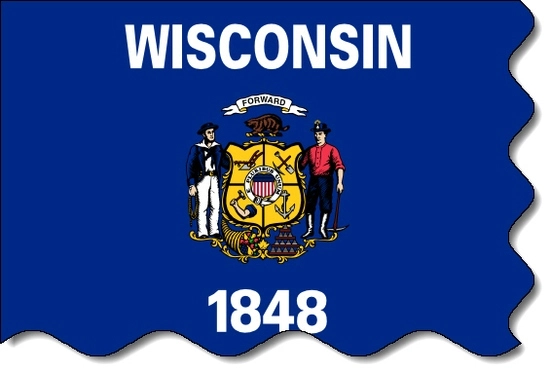
Nearby Labcorp Blood Testing facilities:
- Labcorp Center Distance: 4 m, 3402 Kinsman Blvd, Madison, Dane County, WI, 53704
- Labcorp Center Distance: 66 m, 12555 W National Ave, New Berlin, Waukesha County, WI, 53151
- Labcorp Center Distance: 67 m, 2645 N Mayfair Rd Suite 110, Milwaukee, Milwaukee County, WI, 53226
- Labcorp Center Distance: 68 m, 8500 W Capitol Suite 201B, Milwaukee, Milwaukee County, WI, 53222
- Labcorp Center Distance: 70 m, 5631 W Lincoln Ave, West Allis, Milwaukee County, WI, 53219
- Labcorp Center Distance: 71 m, 136 N Main St Suite 309, Thiensville, Ozaukee County, WI, 53092
- Labcorp Center Distance: 72 m, 1502 S. Layton Blvd, Milwaukee, Milwaukee County, WI, 53215
- Labcorp Center Distance: 79 m, 5911 Northwest Highway Ste 108, Crystal Lake, McHenry County, IL, 60014
- Labcorp Center Distance: 86 m, 6530 Sheridan Road, Kenosha, Kenosha County, WI, 53143
- Labcorp Center Distance: 90 m, 35 Tower Ct Ste E, Gurnee, Lake County, IL, 60031
- Labcorp Center Distance: 94 m, 2338 Higgins Rd, Hoffman Estates, Cook County, IL, 60195
- Labcorp Center Distance: 95 m, 141 E. Irving Park Road, Streamwood, Cook County, IL, 60107
- Labcorp Center Distance: 98 m, 121 South Wilke Rd 405, Arlington Heights, Cook County, IL, 60005
- Labcorp Center Distance: 99 m, 725 W Fabayan Parkway Suite D, Batavia, Kane County, IL, 60510
Nearby Quest Blood Testing facilities:
- Quest Center Distance: 55 m, 5901 E Riverside Blvd, Rockford, Winnebago County, IL, 61114-4935
- Quest Center Distance: 59 m, 641 Highgrove Pl, Rockford, Winnebago County, IL, 61108-2506
- Quest Center Distance: 67 m, 2600 N Mayfair Rd, Wauwatosa, Milwaukee County, WI, 53226-1309
- Quest Center Distance: 74 m, 4852 S 6Th St, Milwaukee, Milwaukee County, WI, 53221-2462
- Quest Center Distance: 79 m, 260 E Congress Pkwy, Crystal Lake, McHenry County, IL, 60014-6235
- Quest Center Distance: 81 m, 10117 74Th St, Kenosha, Kenosha County, WI, 53142-7533
- Quest Center Distance: 82 m, 1854 E Grand Ave, Lindenhurst, Lake County, IL, 60046-7821
- Quest Center Distance: 83 m, 3244 Sycamore Rd, Dekalb, Dekalb County, IL, 60115-4941
- Quest Center Distance: 86 m, 22285 Pepper Rd, Barrington, Lake County, IL, 60010-2538
- Quest Center Distance: 89 m, 15 Tower Ct, Gurnee, Lake County, IL, 60031-5708
- Quest Center Distance: 90 m, 885 S Randall Rd, Elgin, Kane County, IL, 60123-3002
- Quest Center Distance: 92 m, 565 Lakeview Pkwy, Vernon Hills, Lake County, IL, 60061-1839
- Quest Center Distance: 94 m, 337 W Northwest Hwy, Palatine, Cook County, IL, 60067-2414
- Quest Center Distance: 96 m, 1450 Busch Pkwy, Buffalo Grove, Lake County, IL, 60089-4541
- Quest Center Distance: 97 m, 2631 Williamsburg Ave, Geneva, Kane County, IL, 60134-1111
- Quest Center Distance: 98 m, 1100 W Central Rd, Arlington Heights, Cook County, IL, 60005-2402
Madison Wisconsin Hormone Replacement Therapy Services
If you've ever considered Human Growth Hormone Therapy, Testosterone Patches, or any other form of Hormone Treatment, the Conscious Evolution Institute is here to guide you by the hand on your quest to improve your health and wellness. We are a board-certified, licensed Hormone Clinic which offers our services to men and women thirty years of age and older all throughout the United States. We have highly talented and qualified medical affiliates in the Madison Area that can provide us with the medical data that we need to assess your personal need for Hormone Optimization and Balancing.
With our Comprehensive Hormone Panel, a simple blood test allows us to assess your health and hormone state via a number of different parameters, which can show us clearly what your physiological needs are as a patient. We measure Testosterone Levels (Free and Bound), IGF-1 Levels, Cholesterol, and more, in an effort to not only assess your need for Hormone Therapy, but to determine what other medical treatments and health regimens suit you as an individual patient.
Just give us a call at the number you see at the top of the page, or fill out the form to your right to speak with one of our friendly Hormone Specialists. For patients looking to lose weight, also ask about our weight loss programs, including HCG Injection Therapy for weight loss.
Madison Wisconsin HGH Injection Therapy Clinics
Human Growth Hormone Injection Treatments are one of the many HRT Products that we offer at our Hormone Therapy Clinic. There is a vast amount of clinical evidence which show that maintaining HGH Levels at an optimal balance can improve both health and quality of life. If you've noticed a lack of energy as you grow older, combined with weight gain, depression, reduced healing capacity, and trouble getting over common illnesses, you may be a candidate for the HGH Shots that we provide. If you are looking for an HGH Doctor in your area, we've got you covered.
There are a number of HGH Brands and Products out there, ncluding Norditropin, Omnitrope, and Humatrope. We can offer you the cheapest prices for real quality HGH Injection Treatments, and offer HGH Pens and other tools to make the treatment process as simple as possible for you as a patient.
Madison Sermorelin Treatments for Hypopituitarism
While Human Growth Hormone Therapy is highly effective, there is another option available to patients struggling with HGH Deficiency: Sermorelin Acetate. Sermorelin is the functional analog of a hormone known as GH-RH, which stimulates natural release of Human Growth Hormone by the pituitary. For most patients with Age-Related HGH Decline, Sermorelin is just as effective as the real thing at improving Human Growth Hormone Levels in the body, and there is evidence that it does so in a more physiologically natural way, all while being less expensive! Our Sermorelin Specialists and Hormone Doctors can help you decide which medical treatment will most effectively meet your needs.
Madison Wisconsin Low-T Andropause Therapy with Testosterone
The Conscious Evolution Institute also offers Testosterone Therapy to aging men suffering from medical issues associated with Low-T, also known as Testosterone Deficiency. Testosterone Products range from Testosterone Enanthate to Topical Low-T, and all are effective in their own way at getting Serum Testosterone Levels back on track.
Madison Wisconsin Information
Madison is located in south-central Wisconsin, not far from the Illinois border. Madison is the capital city of Wisconsin, and is often referred to by other names, including Mad City and Madtown. The city is also often called The City of Four Lakes, because the city straddles the Yahara River at a point in which it passes through four adjoining lakes: Lake Kegonsa, Lake Waubesa, Lake Monona, and Lake Mendota. The heart of Madison stretches between Lake Mendota and Lake Monona.
The city of Madison is named after the president of the same name, James Madison. The city was actually designed with the intention of being the capital city of Wisconsin, as it was a strategic location among Milwaukee, Green Bay, and various mining and wilderness outposts to the south and west. Even the original streets were named after the thirty-nine men that signed the Constitution.
Neighborhoods in Madison Wisconsin include Regent, Sunset Village, Vilas, Greenbush, Capitol, Tenney-Lapham, and Marquette.
Madison Wisconsin Jobs and Employment
Being the capital of the state of Wisconsin, Madison's primary employers are the University of Wisconsin Hospital, the University of Wisconsin-Madison, and the state government. Other medical institutions in Wisconsin include the Madison VA Medical Center, Meriter Hospital, and St. Mary's Hospital.
Aside from medicine, education, and government, there are many companies that operate out of or are based in Madison, including National Guardian Life, American Family Insurance, MGE Energy, Alliant Energy, and Spectrum Brands. There is also a large technological presence in Madison, with companies like TDS Telecom, Raven Software, Full Compass Systems, Microsoft, and Google housing offices in the city.
Madison Wisconsin Places, Events, and Lifestyle
Madison Wisconsin is widely regarded as one of the nicest cities to live in in the United States, largely because of the plethora of quality job opportunities in the city, combined with its safety and high standard of living. It is also regarded as one of the healthiest cities in America. The most popular part of Madison is easily State Street, which connects the Capitol Square with the campus of the University of Wisconsin. This strip is well-known for its shops, bars, and restaurants, and is the prime spot for quality entertainment and culture in Madison.
Madison also hosts a large number of annual events which contribute to the cultural identity of the area's residents. Some of these events include the State Street Halloween Party, the Mifflin Street Block Party, the Great Taste of the Midwest, and the Wisconsin Film Festival.
There are a number of interesting cultural and historical locations all throughout Madison, including the Henry Vilas Zoo, the Madison Museum of Contemporary Art, and the Chazen Museum of Art. Madison Wisconsin is also well-regarded as a huge sports town, largely the result of the Wisconsin Badgers, which play at Camp Randall Stadium.
All About Madison, Wisconsin Geographic Area
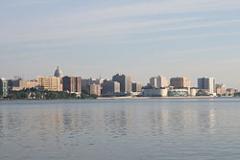

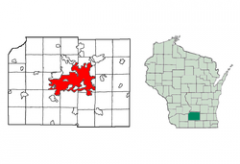
Madison is the capital of the U.S. state of Wisconsin and the county seat of Dane County. As of July 1, 2011, Madison had a population of 236,901. making it the second largest city in Wisconsin, after Milwaukee, and the 81st largest in the United States. The city forms the core of the United States Census Bureau's Madison Metropolitan Statistical Area, which includes all of Dane County and neighboring Iowa and Columbia counties. The Madison Metropolitan Statistical Area had a 2010 population of 568,593.
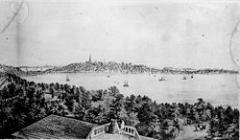
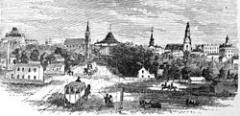
Madison's origins begin in 1829, when former federal judge James Duane Doty purchased over a thousand acres (4 km ²) of swamp and forest land on the isthmus between Lakes Mendota and Monona, with the intention of building a city in the Four Lakes region. When the Wisconsin Territory was created in 1836 the territorial legislature convened in Belmont, Wisconsin. One of the legislature's tasks was to select a permanent location for the territory's capital. Doty lobbied aggressively for Madison as the new capital, offering buffalo robes to the freezing legislators and promising choice Madison lots at discount prices to undecided voters . He had James Slaughter plat two cities in the area, Madison and "The City of Four Lakes", near present-day Middleton. Doty named the city Madison for James Madison, the fourth President of the U.S. who had died on June 28, 1836 and he named the streets for the other 38 signers of the U.S. Constitution. Although the city existed only on paper, the territorial legislature voted on November 28 in favor of Madison as its capital, largely because of its location halfway between the new and growing cities around Milwaukee in the east and the long established strategic post of Prairie du Chien in the west, and between the highly populated lead mining regions in the southwest and Wisconsin's oldest city, Green Bay in the northeast. Being named for the much-admired founding father James Madison, who had just died, and having streets named for each of the 39 signers of the Constitution, may have also helped attract votes.
The cornerstone for the Wisconsin capitol was laid in 1837, and the legislature first met there in 1838. On October 9, 1839, Kintzing Prichett registered the plat of Madison at the registrar's office of the then-territorial Dane County. Madison was incorporated as a village in 1846, with a population of 626. When Wisconsin became a state in 1848, Madison remained the capital, and the following year it became the site of the University of Wisconsin (now University of Wisconsin aeMadison). The Milwaukee & Mississippi Railroad (a predecessor of the Milwaukee Road) connected to Madison in 1854. Madison incorporated as a city in 1856, with a population of 6,863, leaving the unincorporated remainder as a separate Town of Madison. The original capitol was replaced in 1863 and the second capitol burned in 1904. The current capitol was built between 1906 and 1917.
During the Civil War, Madison served as a center of the Union Army in Wisconsin. The intersection of Milwaukee, East Washington, Winnebago and North Streets is known as Union Corners, because a tavern located there was the last stop for Union soldiers before heading to fight the Confederates. Camp Randall, on the west side of Madison, was built and used as a training camp, a military hospital, and a prison camp for captured Confederate soldiers. After the war ended, the Camp Randall site was absorbed into the University of Wisconsin and Camp Randall Stadium was built there in 1917. In 2004 the last vestige of active military training on the site was removed when the stadium renovation replaced a firing range used for ROTC training.
The City of Madison continued annexations from the Town of Madison almost from the date of the city's incorporation, leaving the latter a collection of discontinuous areas subject to annexation. In the wake of continued controversy and an effort in the state legislature to simply abolish the town, an agreement was reached in 2003 to provide for the incorporation of the remaining portions of the Town into the City of Madison and the City of Fitchburg by October 30, 2022.

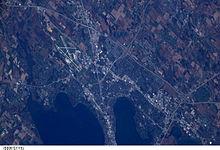
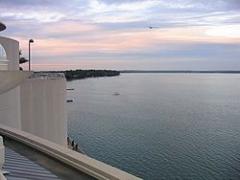
Madison is located in the center of Dane County in south-central Wisconsin, 77 miles (124 km) west of Milwaukee and 122 miles (196 km) northwest of Chicago. The city completely surrounds the smaller Town of Madison, the City of Monona, and the villages of Maple Bluff and Shorewood Hills. Madison shares borders with its largest suburb, Sun Prairie, and three other communities, Middleton, McFarland and Fitchburg. The city's boundaries also approach the villages of Verona, Cottage Grove, DeForest, and Waunakee.
According to the United States Census Bureau, Madison's area is 84.7 square miles (219.4 km2), of which, 68.7 square miles (177.9 km2) of it is land and 16.0 square miles (41.4 km2) of it (18.9%) is water.
The city is sometimes described as The City of Four Lakes, comprising the four successive lakes of the Yahara River: Lake Mendota ("Fourth Lake"), Lake Monona ("Third Lake"), Lake Waubesa ("Second Lake") and Lake Kegonsa ("First Lake"), although Waubesa and Kegonsa are not actually in Madison, but just south of it. A fifth smaller lake, Lake Wingra, is within the city as well; it is connected to the Yahara River chain by Wingra Creek. The Yahara flows into the Rock River, which in turn, flows into the Mississippi River. Downtown Madison is located on an isthmus between Lakes Mendota and Monona. The city's trademark of "Lake, City, Lake" reflects this geography.
Local identity varies throughout Madison, with over 120 officially recognized neighborhood associations. Neighborhoods on and near the eastern part of the isthmus, some of the city's oldest, have the strongest sense of identity and are the most politically liberal. Historically, the north, east, and south sides were blue collar while the west side was white collar, and to a certain extent this remains true. Students dominate on the University of Wisconsin campus and to the east into downtown, while to its south and in Shorewood Hills on its west, faculty have been a major presence since those neighborhoods were originally developed. The turning point in Madison's development was the university's 1954 decision to develop its experimental farm on the western edge of town; since then, the city has grown substantially along suburban lines.
Madison, along with the rest of the state, has a humid continental climate (Koppen: Dfb/Dfa), characterized by variable weather patterns and a large seasonal temperature variance: winter temperatures can be well below freezing, with moderate to occasionally heavy snowfall; high temperatures in summer average in the lower 80s °F (27 ae28 °C), reaching 90 °F (32.2 °C) on an average 12 days per year, often accompanied by high humidity levels. The warmer months usually see greater precipitation.
As of the census of 2010, there were 233,209 people, 89,019 households and 42,462 families residing in the city. The population density was 3,029.7 people per square mile (1,169.8/km ²). There were 108,843 housing units at an average density of 1,345.4 per square mile (519.5/km ²). The racial makeup of the city was 83.96% White, 7.07% African American, 0.36% Native American, 7.34% Asian, 0.04% Pacific Islander, 1.67% from other races and 2.55% from two or more races. 6.83% of the population were Hispanic or Latino of any race.
There were 89,019 households out of which 22.1% had children under the age of 18 living with them, 37.0% were married couples living together, 7.8% had a female householder with no husband present, and 52.3% were non-families. 35.3% of all households were made up of individuals and 7.1% had someone living alone who was 65 years of age or older. The average household size was 2.19 and the average family size was 2.87.
In the city the population was spread out with 17.9% under the age of 18, 21.4% from 18 to 24, 32.2% from 25 to 44, 19.3% from 45 to 64, and 9.2% who were 65 years of age or older. The median age was 31 years. For every 100 females there were 96.6 males. For every 100 females age 18 and over, there were 95.0 males.
The median income for a household in the city was $41,941, and the median income for a family was $59,840. Males had a median income of $36,718 versus $30,551 for females. The per capita income for the city was $23,498. About 5.8% of families and 15.0% of the population were below the poverty line, including 11.4% of those under age 18 and 4.5% of those age 65 or over.
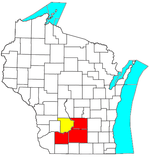
Madison is the larger principal city of the Madison-Baraboo CSA, a Combined Statistical Area that includes the Madison metropolitan area (Columbia, Dane and Iowa counties) and the Baraboo micropolitan area (Sauk County), which had a combined population of 630,569 at the 2010 census.
Madison has a mayor-council system of government. Madison's city council, known as the Common Council, consists of 20 members, one from each district. The mayor is elected in a citywide vote.
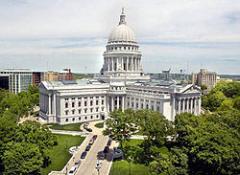
City voters have supported the Democratic Party in national elections in the last half-century, and a liberal and progressive majority is generally elected to the city council. Detractors often refer to Madison as The People's Republic of Madison, the "Left Coast of Wisconsin" or as "78 square miles surrounded by reality." This latter phrase was coined by former Wisconsin Republican governor Lee S. Dreyfus, while campaigning in 1978, as recounted by campaign aide Bill Kraus.
The city's voters are generally much more liberal than voters in the rest of Wisconsin. For example, 76% of Madison voters voted against a 2006 state constitutional amendment to ban gay marriage, even though the ban passed statewide with 59% of the vote.
Madison city politics remain dominated by activists of liberal and progressive ideologies. In 1992, a local third party, Progressive Dane, was founded. Recently enacted city policies supported in the Progressive Dane platform have included an inclusionary zoning ordinance, later abandoned by the mayor and a majority of the city council, and a city minimum wage. The party holds several seats on the Madison City Council and Dane County Board of Supervisors, and is aligned variously with the Democratic and Green parties.
In early 2011, Madison was the site for large protests against a bill proposed by Governor Scott Walker that removed collective bargaining rights for public worker unions. The protests at the capitol ranged in size from 10,000 to over 100,000 people and lasted for several months.
In the 1960s and 1970s, the Madison counterculture was centered in the neighborhood of Mifflin and Bassett streets, referred to as "Miffland". The area contained many three-story apartments where students and counterculture youth lived, painted murals, and operated the co-operative grocery store, the Mifflin Street Co-op. Residents of the neighborhood often came into conflict with authorities, particularly during the administration of Republican mayor Bill Dyke. Dyke was viewed by students as a direct antagonist in efforts to protest the Vietnam War because of his efforts to suppress local protests. The annual Mifflin Street Block Party became a focal point for protest, although by the late 1970s it had become a mainstream community party.
During the late 1960s and early 1970s, thousands of students and other citizens took part in anti-Vietnam War marches and demonstrations, with more violent incidents drawing national attention to the city and UW campus. These include:
These protests were the subject of the documentary The War at Home. David Maraniss's book, They Marched into Sunlight, incorporated the 1967 Dow protests into a larger Vietnam War narrative. Tom Bates wrote the book Rads on the subject (ISBN 0-06-092428-4). Bates wrote that Dyke's attempt to suppress the annual Mifflin Street block party "would take three days, require hundreds of officers on overtime pay, and engulf the student community from the nearby Southeast Dorms to Langdon Street's fraternity row. Tear gas hung like heavy fog across the Isthmus." In the fracas, student activist Paul Soglin, then a city alderman, was arrested twice and taken to jail. Soglin was later elected mayor of Madison, serving from 1973 to 1979, 1989 to 1997, and is the current mayor, elected again in April, 2011. During his middle term he led the construction of the Frank Lloyd Wright designed Monona Terrace.
Madison is home to the Freedom from Religion Foundation, which attempts to influence government in matters relating to the separation of church and state. The foundation is known for its lawsuits against religious displays on public property, and for advocating removal of "In God We Trust" from American currency.
Madison is associated with "Fighting Bob" La Follette and the Progressive movement. La Follette's magazine, The Progressive, founded in 1909, is still published in Madison.
Madison is the episcopal see for the Roman Catholic Diocese of Madison. Saint Raphael's Cathedral, damaged by arson in 2005 and demolished in 2008, was the mother church of the diocese.
The world's largest congregation of Unitarian Universalists, the First Unitarian Society of Madison, makes its home in the historic Unitarian Meeting House, designed by one of its members, Frank Lloyd Wright.
InterVarsity Christian Fellowship/USA has its headquarter in Madison. The city also has a Buddhist temple, a Hindu temple, three mosques and several synagogues, a BahR¡'R community center, an LDS stake, and a Unity Church congregation.
Wisconsin state government and the University of Wisconsin aeMadison remain the two largest Madison employers. However, Madison's economy today is evolving from a government-based economy to a consumer services and high-tech base, particularly in the health, biotech and advertising sectors. Beginning in the early 1990s, the city experienced a steady economic boom and has been less affected by recession than other areas of the state. Much of the expansion has occurred on the city's south and west sides, but it has also affected the east side near the Interstate 39-90-94 interchange and along the northern shore of Lake Mendota. Underpinning the boom is the development of high-tech companies, many fostered by UW aeMadison working with local businesses and entrepreneurs to transfer the results of academic research into real-world applications, especially bio-tech applications.
Many businesses are attracted to Madison's skill base, taking advantage of the area's high level of education. 48.2% of Madison's population over the age of 25 holds at least a bachelor's degree. Forbes magazine reported in 2004 that Madison has the highest percentage of individuals holding Ph.D.s in the United States. In 2006, the same magazine listed Madison as number 31 in the top 200 metro areas for "Best Places for Business and Careers." Madison has also been named in Forbes ten Best Cities several times within the past decade. In 2009, in the midst of the late-2000s recession, Madison had an unemployment rate of 3.5% and was ranked number one in a list of "ten cities for job growth".
The largest employer in Madison is the Wisconsin state government, excluding employees of the University of Wisconsin aeMadison, and University of Wisconsin Hospital and Clinics employees, although both groups of workers are state employees.
The University of Wisconsin Hospital and Clinics is an important regional teaching hospital and regional trauma center, with strengths in transplant medicine, oncology, digestive disorders, and endocrinology. Other Madison hospitals include St. Mary's Hospital, Meriter Hospital, and the VA Medical Center.
Madison is home to companies such as Spectrum Brands (formerly Rayovac), Alliant Energy, American Family Insurance, American Girl (a subsidiary of Mattel), the Credit Union National Association and its CUNA Mutual Group, Dean Health Systems, Madison-Kipp Corporation, Pacific Cycle, Schoeps Ice Cream, and Sub-Zero & Wolf Appliance. Technology companies in the area include Berbee Information Networks, Broadjam, Epic, FSBO Madison, Full Compass Systems, Human Head Studios, Netconcepts (recently purchased by Covario), Raven Software, Sonic Foundry, TDS Telecom, and TomoTherapy.
Biotech firms include Panvera (now part of Invitrogen), Promega, and the Iceland-based Nimblegen. The contract research organization Covance is a major employer in the area.
Oscar Mayer has been a Madison fixture for decades, and was a family business for many years before being sold to Kraft Foods. The Onion newspaper and the pizza chains Rocky Rococo, the Glass Nickel Pizza Company, and Ian's Pizza originated in Madison.
In the mid-2000s Madison partnered with Merrimac Communications to develop and build Mad City Broadband, a wireless internet infrastructure for the city. In early 2010 a grass-root effort to bring Google's new high-speed fiber Internet to Madison failed.
Madison is served by Madison Gas and Electric which provides electricity and natural gas service to the city.
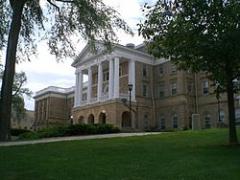
According to Forbes magazine, Madison ranks second in the nation in education. The Madison Metropolitan School District serves the city and surrounding area. With an enrollment of approximately 25,000 students in 46 schools, it is the second largest school district in Wisconsin behind the Milwaukee School District. The five public high schools are James Madison Memorial, Madison West, Madison East, Madison LaFollette, and Malcolm Shabazz City High School, an alternative school.
Among private church-related high schools are Abundant Life Christian School, Edgewood High School, located on the Edgewood College campus, and St. Ambrose Academy, a Catholic school offering grades 6 through 12. Madison Country Day School is a private high school with no religious affiliation.
The city is home to the University of Wisconsin aeMadison, Edgewood College, Madison Area Technical College, and Madison Media Institute, giving the city a post-secondary student population of nearly 50,000. The University of Wisconsin accounts for the vast majority of students, with an enrollment of roughly 41,000, of whom 30,750 are undergraduates. In a Forbes magazine city ranking from 2003, Madison had the highest number of Ph.D.s per capita, and third highest college graduates per capita,among cities in the United States.[dead link]
Additional degree programs are available through satellite campuses of Cardinal Stritch University, Concordia University-Wisconsin, Globe University, Lakeland College, the University of Phoenix, and Upper Iowa University. Madison also has a non-credit learning community with multiple programs and many private businesses also offering classes.
Madison is served by the Dane County Regional Airport, which serves more than 100 commercial flights on an average day, and nearly 1.6 million passengers annually. Most major general aviation operations take place at Morey Field in Middleton 15 miles (24 km) from the city center. Madison Metro operates bus routes throughout the city and to some surrounding towns. Madison has four taxicab companies (Union, Badger, Madison and Green), and several companies provide specialized transit for individuals with disabilities.
A high-speed rail route from Chicago through Milwaukee and Madison to Minneapolis/St. Paul, Minnesota, was proposed as part of the Midwest Regional Rail Initiative. Funding for the railway connecting Madison to Milwaukee was approved in January, 2010, but Governor-elect Scott Walker's opposition to the project led the Federal Railroad Administration to retract the $810 million in funding and reallocate it to other projects. The nearest passenger train station is in Columbus, Wisconsin, 28 miles (45 km) away. There the eastbound Empire Builder provides daily service to Milwaukee and Chicago, and the westbound Empire Builder provides daily service to Portland, Oregon and Seattle, Washington.
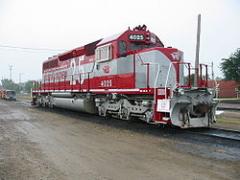
Railroad freight services are provided to Madison by Wisconsin and Southern Railroad (WSOR) and Canadian Pacific Railway (CP). Wisconsin & Southern has been operating since 1980, having taken over trackage owned since the 19th century by the Chicago and North Western and the Milwaukee Road.
The Transport 2020 project proposed a hybrid commuter rail-light rail transit line along one of the existing rail corridors from Middleton, Wisconsin to Reiner Road between Madison and Sun Prairie, Wisconsin, serving the University Avenue corridor, UW-Madison campus, the isthmus, and northeast Madison. In June 2008, the project submitted an application with the Federal Transit Administration to begin preliminary engineering for the project. However, in June 2011, authorizing legislation for regional transit authorities in Wisconsin was repealed and the application was withdrawn. The project is currently on hold.
Regional buses connect Madison to Milwaukee, Chicago, Minneapolis aeSaint Paul, and many other communities. Badger Bus, which connects Madison to Milwaukee, runs about 10 buses a day. Greyhound Lines, a nationwide bus company, serves Madison on its Chicago, Milwaukee, and Minneapolis aeSaint Paul route. Van Galder Bus Company, a subsidiary of Coach USA, provides transportation through Rockford to Chicago ae stopping at Union Station, O'Hare Airport, and Midway Airport. Jefferson Lines provides transportation to Minneapolis aeSaint Paul via La Crosse. Megabus provides limited stop service to Chicago and Minneapolis aeSaint Paul. Lamers Bus Lines has once daily trips from Madison to Wausau, Dubuque, and Green Bay.
I-39, I-90 and I-94 expressways intersect at Madison, connecting the city to Milwaukee, Chicago, Rockford, Illinois, Minneapolis-St. Paul, and Wausau. U.S. Routes US-12, US-14, US-18, US-51 and US-151 connect the city with Dubuque, Iowa, the Wisconsin cities of La Crosse and Janesville, Fond du Lac and Manitowoc. The Beltline is a six-to-eight lane freeway on the south and west sides of Madison and is the main link from downtown to the southeast and western suburbs. Several carsharing services are available in Madison, including Community Car a locally-owned company, and U-Haul subsidiary U Car Share.
Madison is home to an extensive and varied number of print publications, reflecting the city's role as the state capital and its diverse political, cultural and academic population. The Wisconsin State Journal (weekday circulation: ~95,000; Sundays: ~155,000) is published in the mornings, while its sister publication, The Capital Times (Thursday supplement to the Journal) is published online daily. Though jointly operated under the name Capital Newspapers, the Journal is owned by the national chain Lee Enterprises, and the Times is independently owned. Wisconsin State Journal is the descendant of the Wisconsin Express, a paper founded in the Wisconsin Territory in 1839. The Capital Times was founded in 1917 by William T. Evjue, a business manager for the State Journal who disagreed with that paper's editorial criticisms of Wisconsin Republican Senator Robert M. La Follette, Sr. for his opposition to U.S. entry into World War I.
The free weekly alternative newspaper Isthmus (weekly circulation: ~65,000) was founded in Madison in 1976. The Onion, a satirical weekly, was founded in Madison in 1988. Two student newspapers are published during the academic year, The Daily Cardinal (Mon-Fri circulation: ~10,000) and The Badger Herald (Mon-Fri circulation: ~16,000). Other specialty print publications focus on local music, politics and sports, including The Madison Times, Wisconsin Sports Weekly,The Mendota Beacon, The Madison Observer, Madison Magazine, The Simpson Street Free Press and fantasy sports web site RotoWire.com. There is a strong community of local blogs including Althouse, dane101, and The Critical Badger.
The Progressive, published in Madison, is a left-wing periodical that may be best known for the attempt of the U.S. government in 1979 to suppress one of its articles before publication. The magazine eventually prevailed in the landmark First Amendment case, United States v. The Progressive, Inc. During the 1970s, there were two radical weeklies published in Madison, known as TakeOver and Free for All, as well as a Madison edition of the Bugle-American underground newspaper.
Madison hosts two volunteer-operated and community-oriented radio stations, WORT and WSUM. WORT Community Radio (89.9 FM), founded in 1975, is one of the oldest volunteer-powered radio stations in the United States. A listener-sponsored community radio station, WORT offers diverse music and talk programming that is locally produced and hosted by local DJs. WSUM (91.7 FM) is a student radio station whose programming and operation are carried out almost entirely by students.
Madison's Wisconsin Public Radio station, WHA, was one of the first radio stations in the nation to begin broadcasting, and remains the longest continuously broadcasting station in the nation.
Widely heard public radio programs that originate in Madison include Michael Feldman's Whad'Ya Know?, Zorba Pastor On Your Health, To the Best of Our Knowledge and Calling All Pets.
WXJ-87 is the NOAA Weather Radio All Hazards station located on Madison's west side, with broadcasts originating from the National Weather Service in Sullivan, Wisconsin.
See also:
In 1996 Money magazine identified Madison as the best place to live in the United States. It has consistently ranked near the top of the best-places list in subsequent years, with the city's low unemployment rate a major contributor.
The main downtown thoroughfare is State Street, which links the University of Wisconsin campus with the Capitol Square, and is lined with restaurants, espresso cafes and shops. Only pedestrians, buses, emergency vehicles, delivery vehicles and bikes are allowed on State Street.
On the other side of Capitol Square is King Street, which has more upper-end restaurants and cafes than on the more student-budget State Street.

On Saturday mornings in the summer, the Dane County Farmers' Market is held around the Capitol Square. This market attracts numerous vendors who sell fresh produce, meat, cheese, and other products. On Wednesday evenings, the Wisconsin Chamber Orchestra performs free concerts on the capitol's lawn.
The Great Taste of the Midwest craft beer festival, established in 1987 and the second longest running such event in North America, is held the second Saturday in August. The highly-coveted tickets sell out within an hour of going on sale in May.
Madison is host to Rhythm and Booms, a massive fireworks celebration coordinated to music. It begins with a fly-over by F-16s from the local Wisconsin Air National Guard. This celebration is the largest fireworks display in the Midwest in length, number of shells fired and the size of its annual budget.
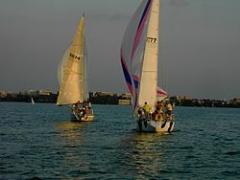
During the winter months, sports enthusiasts enjoy ice-boating, ice skating, ice hockey, ice fishing, cross-country skiing, and snowkiting. During the rest of the year, outdoor recreation includes sailing on the local lakes, bicycling, and hiking.
Madison was named the number one college sports town by Sports Illustrated in 2003. In 2004 it was named the healthiest city in America by Men's Journal magazine. Many major streets in Madison have designated bike lanes and the city has one of the most extensive bike trail systems in the nation.
There are many cooperative organizations in the Madison area, ranging from grocery stores (such as the Willy Street Cooperative) to housing co-ops (such as Madison Community Cooperative and Nottingham Housing Cooperative) to worker cooperatives (including and engineering firm and a cab company).
In 2005, Madison was included in Gregory A. Kompes' book, 50 Fabulous Gay-Friendly Places to Live. The Madison metro area has a higher percentage of gay couples than any other city in the area outside of Chicago and Minneapolis.
Among the city's neighborhood fairs and celebrations are two large student-driven gatherings, the Mifflin Street Block Party and the State Street Halloween Party. Rioting and vandalism at the State Street gathering in 2004 and 2005 led the city to institute a cover charge for the 2006 celebration. In an attempt to give the event more structure and to eliminate vandalism, the city and student organizations worked together to schedule performances by bands, and to organize activities. The event has been named "Freakfest on State Street." Events such as these have helped contribute to the city's nickname of "Madtown."
In 2009, the Madison Common Council voted to name the plastic pink flamingo as the official city bird.
Madison's vibrant music scene covers a wide spectrum of musical culture.
Several venues offer live music nightly, spreading from the historic Barrymore Theatre and High Noon Saloon on the east side to small coffee houses and wine bars. The biggest headliners usually perform at the Orpheum Theatre, the Overture Center or the UW Theatre on campus. Other popular rock and pop venues include the Majestic Theater, the Frequency, and the Great Dane Pub. During the summer, the Memorial Union Terrace on the University of Wisconsin campus, offers live music five nights a week. The Union is located on the shores of Lake Mendota and offers beautiful scenery and sunsets.
The Madison Scouts Drum and Bugle Corps has provided youth aged 16 ae22 opportunities to perform across North America every summer since 1938. The University of Wisconsin Marching Band is a popular marching band.
Garbage is the city's most recognized contemporary contribution to popular music. The multi-million album selling alternative-rock band has been based in Madison since it was formed in 1994 by producer-musician Butch Vig of Viroqua. Vig and bandmate Steve Marker also owned Smart Studios in Madison, which closed in 2010.
Madison has a lively independent rock scene, and local independent record labels include Crustacean Records, Science of Sound, Kind Turkey Records, and Art Paul Schlosser Inc. A Dr. Demento and weekly live karaoke favorite is The Gomers, who have a Madison Mayoral Proclamation named after them. They have performed with fellow Wisconsin residents Les Paul and Steve Miller.
Madison is also home to Paul Kowert of Punch Brothers, Mama Digdown's Brass Band, Johnny Rocker & The High Rollers, Clyde Stubblefield of Funky Drummer fame, and musicians Roscoe Mitchell, Richard Davis, Ben Sidran, Reptile Palace Orchestra, Killdozer, and Polydream.
In the summer Madison hosts many music festivals, including the Waterfront Festival, the Willy St. Fair, Atwood Summerfest, the Isthmus Jazz Festival, the Orton Park Festival, 94.1 WJJO's Band Camp, Greekfest, the WORT Block Party and the Sugar Maple Traditional Music Festival. Past festivals include the Madison Pop Festival and Forward Music Festival (2009-2010.) One of the latest additions is the FRªte de Marquette, taking place around Bastille Day at various east side locations. This new festival celebrates French music, with a focus on Cajun influences. Madison also hosts an annual electronic music festival, Reverence, and the Folk Ball, a world music and Folk dance festival held annually in January. Madison is home to the LBGTQA festival, Fruit Fest, celebrating queer culture and LGBT allies. Madison also plays host to the National Women's Music Festival.
Museums include the UW aeMadison's Chazen Museum of Art (formerly the Elvehjem Museum), the Wisconsin Historical Museum (run by the Wisconsin Historical Society), the Wisconsin Veterans Museum, the Madison Children's Museum, and the Madison Museum of Contemporary Art. Madison also has many independent art studios and galleries. It hosts the annual Art Fair on the Square, a juried exhibition, and the complementary Art Fair Off the Square.
The Madison Opera, the Madison Symphony Orchestra, Forward Theatre Company, the Wisconsin Chamber Orchestra, and the Madison Ballet are some of the professional resident companies of the Overture Center for the Arts. The city is also home to a number of smaller performing arts organizations, including a group of theater companies that present in the Bartell Theatre, a former movie palace renovated into live theater spaces, and Opera for the Young, an opera company that performs for elementary school students across the Midwest. The Wisconsin Union Theater (a 1300-seat theater) is home to seasonal attractions and is the main stage for Four Seasons Theatre, a community theater company specializing in musical theater, and other groups. The Young Shakespeare Players, a theater group for young people, performs uncut Shakespeare and George Bernard Shaw plays.
Community-based theater groups include Children's Theatre of Madison, Strollers Theatre, Madison Theatre Guild, the Mercury Players, and the Broom Street Theater (which is not on Broom Street).
Madison offers one comedy club, the Comedy Club on State, and has other options for more alternative humor, featuring several improv groups, such as The Prom Committee, Spin Cycle Improv, Atlas Improv Co., Monkey Business Institute, the now defunct ARC Improv and Comedy Sportz, and sketch comedy groups The Public Drunkards and The Rabid Badger Theatre Company. The WiSUC Project hosts the annual "Funniest Comic in Madison" contest at the High Noon Saloon.
Madison has one of the largest film archives in the nation at the Wisconsin Historical Society.
Several films have been made in Madison. One of the most noted was the documentary The War at Home, which chronicled the anti-Vietnam War movement in Madison. Another that made extensive use of the city as a backdrop was the 1986 comedy Back to School, starring Rodney Dangerfield. The 2006 film The Last Kiss used Madison and the university as a back-drop. In 2008, scenes were shot at the state capitol and surrounding area for use in the 2009 film Public Enemies, featuring Christian Bale and Johnny Depp.

The Wisconsin State Capitol dome, closely based on the dome of the U.S. Capitol, is the jewel of the Madison skyline, and is visible throughout the Madison area because of its position on the high point of the isthmus. A state law limits building heights within one mile (1.6 km) of the structure. The Wisconsin capitol's dome is the second tallest in the nation, after that of the capitol in Washington D.C. Because of its location in the urban core, Capitol Square is well integrated with everyday pedestrian traffic and commerce, and the spoke streets aeespecially State Street and E. Washington aeoffer dramatic views of the capitol.
Architect Frank Lloyd Wright spent much of his childhood in Madison and studied briefly at the University, and is responsible for several Madison buildings. Monona Terrace, a meeting and convention center overlooking Lake Monona, designed by Taliesin Architect Anthony Puttnam, was based loosely on a 1938 Wright design. Wright designed the seminal Usonian House, which is located here. Another key Wright building, the Unitarian Meeting House, is in the adjacent suburb of Shorewood Hills. The Harold C. Bradley House in the University Heights neighborhood, designed collaboratively by Louis H. Sullivan and George Grant Elmslie in 1908 ae1910, now serves as the Sigma Phi Fraternity.
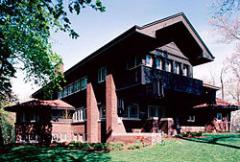
The Overture Center for the Arts, designed by Argentina-born architect Cesar Pelli, stands on State Street near the capitol. Since opening in 2004, the center has presented shows and concerts in its Overture Hall, Capitol Theater and The Playhouse. The center houses the Madison Museum of Contemporary Art. Its style, unlike Pelli's Petronas Towers, leans toward sleek modernism, with simple expanses of glass framed by stone that are intended to complement the historic building facades preserved as part of the building's State Street exposure.
Many of the over 175 Madison buildings designed by the architectural firm of Claude and Starck are still standing, including Breese Stevens Field, Doty School (now converted to condominiums), and many private residences.
The UW aeMadison campus includes many buildings designed or supervised by architects J. T. W. Jennings, including the Dairy Barn and Agricultural Hall, and by Arthur Peabody, including the Memorial Union and the Carillon Tower. The density of the campus has grown to include 8- to 10-story high-rises including dormitories, research facilities, and classrooms. Several campus buildings erected in the 1960s exhibit brutalist architecture, which is now unpopular. In 2005 the University of Wisconsin embarked on a major redevelopment initiative that will transform the east end of its campus. The plan calls for the razing of a nearly a dozen 1950s to 1970s vintage buildings and the construction of new dormitories, administration, and classroom buildings, as well as the development of a new pedestrian mall extending to Lake Mendota.
Over the years, Madison has acquired nicknames and slogans that include:
In 2008, Men's Health magazine ranked Madison as the "Least Armed and Dangerous" city in the United States in an article about "Where Men Are Targets". Between 2004 and 2007, 17 murders were reported. In 2008, Madison Police reported 10 homicides

Madison's reputation as a sports city exists largely because of the University of Wisconsin. In 2004 Sports Illustrated on Campus named Madison the #1 college sports town in the nation. Scott Van Pelt also proclaimed Madison the best college sports town in America.
The UW aeMadison teams play their home-field sporting events in venues in and around Madison. The football team plays at Camp Randall Stadium. In 2005 a renovation was completed that added 72 luxury suites and increased the stadium's capacity to 80,321, although crowds of as many as 83,000 have attended games. The basketball and hockey teams play at the Kohl Center. Construction on the $76 million arena was completed in 1997. In 2006, the men's and women's Badger hockey teams won NCAA Division I championships, and the women repeated with a second consecutive national championship in 2007. Some events are played at the county-owned Alliant Energy Center (formerly Dane County Memorial Coliseum) and the University-owned Wisconsin Field House.
Despite Madison's strong support for college sports, it has proven to be an inhospitable home for professional baseball. The Madison Muskies, a Class A, Midwest League affiliate of the Oakland A's, left town in 1993 after 11 seasons. The Madison Hatters, another Class A, Midwest League team, played in Madison for only the 1994 season. The Madison Black Wolf, an independent Northern League franchise lasted five seasons (1996 ae2000), before decamping for Lincoln, Nebraska. Madison is currently home to the Madison Mallards, a college wood-bat summer baseball league team in the Northwoods League. They play in Warner Park on the city's north side from June to August.
The now defunct Indoor Football League's Madison Mad Dogs were once located in the city. In 2009 indoor football returned to Madison as the Continental Indoor Football League's Wisconsin Wolfpack, who call the Alliant Energy Center home.
Madison is home to the Madison Mustangs, a semi-pro football team that is part of the Ironman Football League. Games are typically played on Saturday during the summer months, with the home field being Middleton High School. The Mustangs have the nation's longest active winning streak at 49 games, and have won 4 straight Ironman Football League championships.
The Wisconsin Wolves is a women's semi-pro football team based in Madison that plays in the IWFL Independent Women's Football League. The Wolves home field is located at Middleton High School.
The Blackhawk Ski Club, formed in 1947, provides ski jumping, cross country skiing and alpine skiing. The club's programs have produced several Olympic ski jumpers, two Olympic ski jumping coaches and one Olympic ski jumping director. The club had the first Nordic ski facility with lighted night jumping.
The Madison 56ers is a Madison amateur soccer team in the National Premier Soccer League. They play in Breese Stevens Field on East Washington Avenue.
Madison is home to the Wisconsin Rugby Club, the 1998 USA Rugby Division II National Champions, and the Wisconsin Women's Rugby Football Club, the state's only Division I women's rugby team. The city also has men's and women's rugby clubs at UW aeMadison, in addition to four high school boy's teams and one high school girl's team. The most recent addition to the Madison rugby community, Madison Minotaurs Rugby Club, is composed largely of gay players and is Wisconsin's first and only IGRAB team, but is open to any player with any experience level. All ten teams play within the Wisconsin Rugby Football Union, the Midwest Rugby Union and USA Rugby.
Nearly 100 women participate in the adult women's ice hockey teams based in Madison (Thunder, Lightning, Freeze, UW aeB and C teams), which play in the Women's Central Hockey League. The Madison Gay Hockey Association is also in Madison.
Madison also has a hurling team, organized as The Hurling Club of Madison.
The All-Girl Roller Derby League, Mad Rollin' Dolls, was formed in Madison in 2004 and is a member of the Women's Flat Track Derby Association.
Madison is home to several endurance sports racing events, such as the Crazylegs Classic, Paddle and Portage, the Mad City Marathon, and Ironman Wisconsin, which attracts over 45,000 spectators.


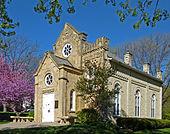
Former sister cities include:

Word Count: 7387





